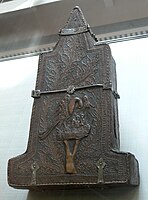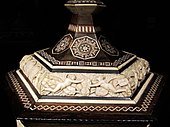
Furniture refers to objects intended to support various human activities such as seating, eating (tables), storing items, working, and sleeping. Furniture is also used to hold objects at a convenient height for work, or to store things. Furniture can be a product of design and can be considered a form of decorative art. In addition to furniture's functional role, it can serve a symbolic or religious purpose. It can be made from a vast multitude of materials, including metal, plastic, and wood. Furniture can be made using a variety of woodworking joints which often reflects the local culture.

Filippino Lippi was an Italian Renaissance painter mostly working in Florence, Italy during the later years of the Early Renaissance and first few years of the High Renaissance. He also worked in Rome for a period from 1488, and later in the Milan area and Bologna.

Andrea Mantegna was an Italian Renaissance painter, a student of Roman archeology, and son-in-law of Jacopo Bellini.

Antonello da Messina, properly Antonello di Giovanni di Antonio, but also called Antonello degli Antoni and Anglicized as Anthony of Messina, was an Italian painter from Messina, active during the Italian Early Renaissance.
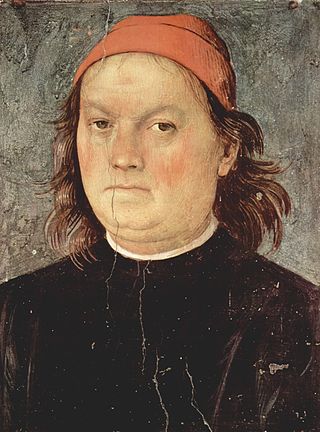
Pietro Perugino, an Italian Renaissance painter of the Umbrian school, developed some of the qualities that found classic expression in the High Renaissance. Raphael became his most famous pupil.

A casket is a decorative box or container that is usually smaller than a chest and is typically decorated. In recent centuries they are often used as boxes for jewelry, but in earlier periods they were also used for keeping important documents and many other purposes. Many ancient caskets are reliquaries, for both Buddhist and Christian relics.

Ivory carving is the carving of ivory, that is to say animal tooth or tusk, generally by using sharp cutting tools, either mechanically or manually. Objects carved in ivory are often called "ivories".

Bone carving is creating art, tools, and other goods by carving animal bones, antlers, and horns. It can result in the ornamentation of a bone by engraving, painting or another technique, or the creation of a distinct formed object. Bone carving has been practiced by a variety of world cultures, sometimes as a cheaper, and recently a legal, substitute for ivory carving. As a material it is inferior to ivory in terms of hardness, and so the fine detail that is possible, and lacks the "lustrous" surface of ivory. The interior of bones are softer and even less capable of a fine finish, so most uses are as thin plaques, rather than sculpture in the round. But it must always have been much easier to obtain in regions without populations of elephants, walrus or other sources of ivory.

Certosina is a decorative art technique of inlaying used widely in the Italian Renaissance period. Similar to marquetry, it uses small pieces of wood, bone, ivory, metal, or mother-of-pearl to create inlaid geometric patterns on a wood base. The term comes from Carthusian monasteries, probably the Certosa di Pavia, where the technique was used in ornamenting an altarpiece by the Embriachi workshop.

The Veroli Casket is a Middle Byzantine casket, probably made in Constantinople in the late 10th or early 11th century, and now in Room 8 of the Victoria and Albert Museum, London. It is thought to have been made for a person close to the Imperial Court of Constantinople, the capital of the Byzantine Empire, and may have been used to hold scent bottles or jewellery. It was later in the Cathedral Treasury at Veroli, south east of Rome, until 1861.

The object called by the museum Casket with Scenes of Romances is a French Gothic ivory casket made in Paris between 1330 and 1350, and now in the Walters Art Museum, Baltimore, Maryland. The casket is 4 5/8 inches high, 9 15/16 inches wide and 5 1/16 inches deep.

The Begram ivories are a group of over a thousand decorative plaques, small figures and inlays, carved from ivory and bone, and formerly attached to wooden furniture, that were excavated in the 1930s in Bagram (Begram), Afghanistan. They are rare and important exemplars of Kushan art of the 1st or 2nd centuries CE, attesting to the cosmopolitan tastes and patronage of local dynasts, the sophistication of contemporary craftsmanship, and to the ancient trade in luxury goods.

Pastiglia, an Italian term meaning "pastework", is low relief decoration, normally modelled in gesso or white lead, applied to build up a surface that may then be gilded or painted, or left plain. The technique was used in a variety of ways in Italy during the Renaissance. The term is mostly found in English applied to gilded work on picture frames or small pieces of furniture such as wooden caskets and cassoni, and also on areas of panel paintings, but there is some divergence as to the meaning of the term between these specialisms.

The Brescia Casket, also called the lipsanotheca of Brescia or reliquary of Brescia, is an ivory box, perhaps a reliquary, from the late 4th century, which is now in the Museo di Santa Giulia at San Salvatore in Brescia, Italy. It is a virtually unique survival of a complete Early Christian ivory box in generally good condition. The 36 subjects depicted on the box represent a wide range of the images found in the evolving Christian art of the period, and their identification has generated a great deal of art-historical discussion, though the high quality of the carving has never been in question. According to one scholar: "despite an abundance of resourceful and often astute exegesis, its date, use, provenance, and meaning remain among the most formidable and enduring enigmas in the study of early Christian art."

The Esquiline Treasure is an ancient Roman silver treasure that was found in 1793 on the Esquiline Hill in Rome. The hoard is considered an important example of late antique silver work from the 4th century AD, probably about 380 for the major pieces. Since 1866, 57 objects, representing the great majority of the treasure, have been in the British Museum.
The Salerno Ivories are a collection of Biblical ivory plaques from around the 11th or 12th century that contain elements of Early Christian, Byzantine, and Islamic art as well as influences from Western Romanesque and Anglo-Saxon art. Disputed in number, it is said there are between 38 and 70 plaques that comprise the collection. It is the largest unified set of ivory carvings preserved from the pre-Gothic Middle Ages, and depicts narrative scenes from both the Old and New Testaments. Some researchers believe the Ivories hold political significance and serve as commentary on the Investiture Controversy through their iconographies. The majority of the plaques are housed in the Diocesan Museum of the Cathedral of Salerno, which is where the group's main namesake comes from. It is supposed the ivories originated in either Salerno and Amalfi, which both contain identified ivory workshops, however neither has been definitively linked to the plaques so the city of origin remains unknown. Smaller groups of the plaques and fragments of panels are currently housed in different museum collections in Europe and America, including the Metropolitan Museum of Art in New York, the Louvre in Paris, the Museum of Fine Arts in Budapest, the Hamburg Museum of Art and Trade, and the Sculpture Collection in the Berlin State Museums.

The collection of the Metropolitan Museum of Art contains a lidded saltceller. Crafted in either 15th or 16th century Sierra Lione, the item is on view at The Met Fifth Avenue in Gallery 352.

The Morgan Casket is a medieval casket from Southern Italy, probably Norman Sicily. However, it reflects the Islamic style of the Fatimid Caliphate in Egypt, the culturally dominant power in the Western Mediterranean at the time. It is made from carved ivory and bone over a wooden framework, and is dated to the 11th–12th centuries AD. It was donated to the New York Metropolitan Museum of Art by the J.P. Morgan estate in 1917. The casket has many images of men and animals, vines and rosettes, and one image of a woman. The carvings are considered among the most beautiful carvings from southern Italy during Norman rule.
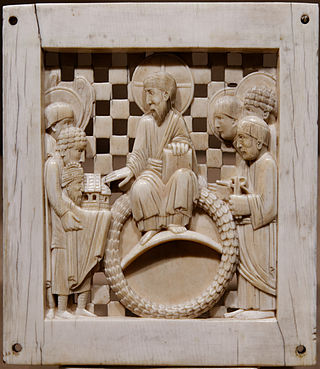
The Magdeburg Ivories are a set of 16 surviving ivory panels illustrating episodes of Christ's life. They were commissioned by Emperor Otto I, probably to mark the dedication of Magdeburg Cathedral, and the raising of the Magdeburg see to an archbishopric in 968. The panels were initially part of an unknown object in the cathedral that has been variously conjectured to be an antependium or altar front, a throne, door, pulpit, or an ambon; traditionally this conjectural object, and therefore the ivories as a group, has been called the Magdeburg Antependium. This object is believed to have been dismantled or destroyed in the 1000s, perhaps after a fire in 1049.
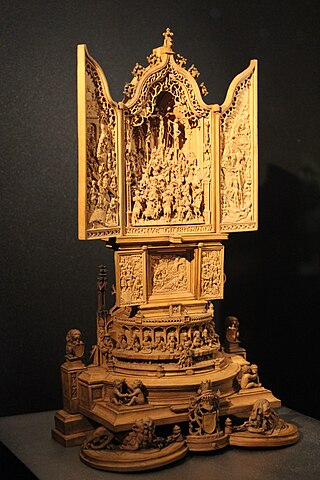
The miniature altarpiece in the British Museum, London, is a very small portable Gothic boxwood miniature sculpture completed in 1511 by the Northern Netherlands master sometimes identified as Adam Dircksz, and members of his workshop. At 25.1 cm (9.9 in) high, it is built from a series of architectural layers or registers, which culminate at an upper triptych, whose centre panel contains a minutely detailed and intricate Crucifixion scene filled with multitudes of figures in relief. Its outer wings show Christ Carrying the Cross on the left, and the Resurrection on the right.










